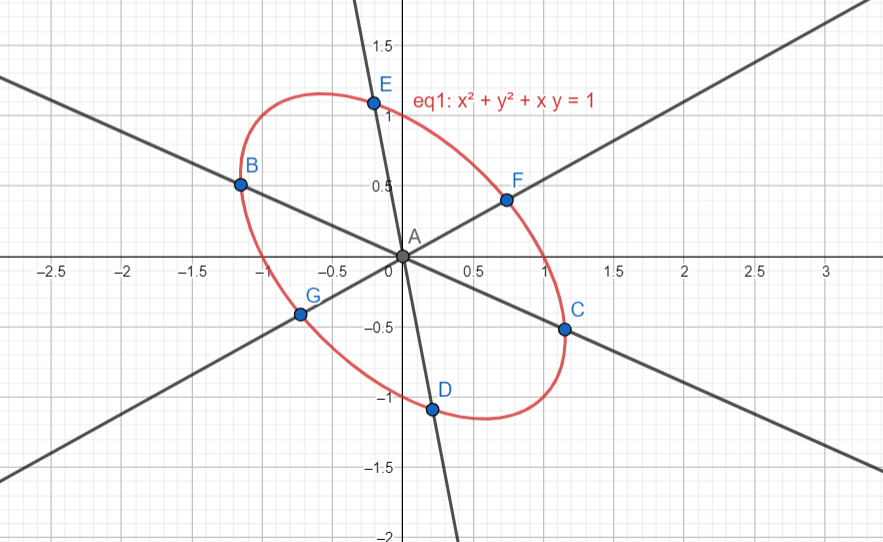
Any chord of the conic ${{x}^{2}}+{{y}^{2}}+xy=1$ passing through the origin is bisected at a point$(p,q)$ then $(p+q+12)$ equals to :
(a) 13
(b) 14
(c) 11
(d) 12
Answer
507.2k+ views
Hint: Make use of the property that says that the centre of a conic bisects every chord that passes through the centre of a conic section.
First, let’s find the centre of this conic section. To find this, let’s first see if the equation changes when we replace $x$ with $y$ and vice versa. If the equation remains unchanged, then that means that the centre of the conic is the origin itself.
Let’s exchange $x$ and $y$ in the equation now. Doing so, we get :
${{y}^{2}}+{{x}^{2}}+yx=1$ which is the same as the original question.
Hence, we know that the centre of this conic is in fact the origin.
It is a property of all conics that every chord drawn in the conic that passes through its centre is bisected by the centre of that conic. Applying this property to this question, since we don’t have one particular chord, and it’s any chord passing through the origin, we can say that $(p,q)$ is actually the centre of this conic. Hence, this point should be equal to the origin since that is the centre of this conic.
$\begin{align}
& (p,q)=(0,0) \\
& \Rightarrow p=0,q=0 \\
& \Rightarrow p+q+12=0+0+12=12 \\
\end{align}$
Hence, $(p+q+12)=12$ in this question.
Note:

Here, A is the centre of the conic, the origin, and as you can see, it bisects every chord that passes through it.
First, let’s find the centre of this conic section. To find this, let’s first see if the equation changes when we replace $x$ with $y$ and vice versa. If the equation remains unchanged, then that means that the centre of the conic is the origin itself.
Let’s exchange $x$ and $y$ in the equation now. Doing so, we get :
${{y}^{2}}+{{x}^{2}}+yx=1$ which is the same as the original question.
Hence, we know that the centre of this conic is in fact the origin.
It is a property of all conics that every chord drawn in the conic that passes through its centre is bisected by the centre of that conic. Applying this property to this question, since we don’t have one particular chord, and it’s any chord passing through the origin, we can say that $(p,q)$ is actually the centre of this conic. Hence, this point should be equal to the origin since that is the centre of this conic.
$\begin{align}
& (p,q)=(0,0) \\
& \Rightarrow p=0,q=0 \\
& \Rightarrow p+q+12=0+0+12=12 \\
\end{align}$
Hence, $(p+q+12)=12$ in this question.
Note:

Here, A is the centre of the conic, the origin, and as you can see, it bisects every chord that passes through it.
Recently Updated Pages
Master Class 11 Business Studies: Engaging Questions & Answers for Success

Master Class 11 Computer Science: Engaging Questions & Answers for Success

Master Class 11 Maths: Engaging Questions & Answers for Success

Master Class 11 Chemistry: Engaging Questions & Answers for Success

Master Class 11 Economics: Engaging Questions & Answers for Success

Master Class 11 Accountancy: Engaging Questions & Answers for Success

Trending doubts
What is meant by exothermic and endothermic reactions class 11 chemistry CBSE

10 examples of friction in our daily life

One Metric ton is equal to kg A 10000 B 1000 C 100 class 11 physics CBSE

1 Quintal is equal to a 110 kg b 10 kg c 100kg d 1000 class 11 physics CBSE

Difference Between Prokaryotic Cells and Eukaryotic Cells

What are Quantum numbers Explain the quantum number class 11 chemistry CBSE




